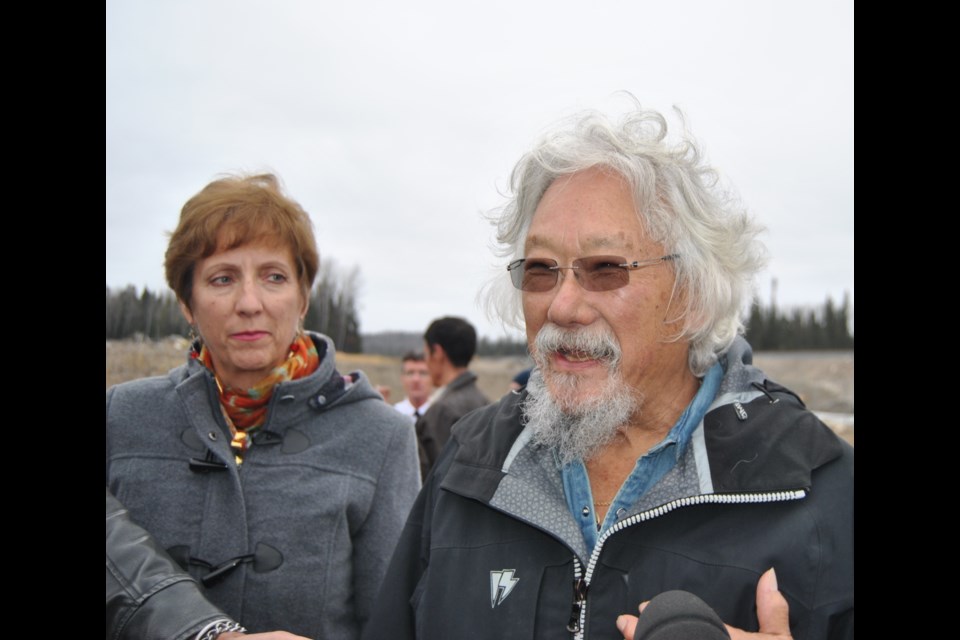The Ministry of the Environment and Climate Change’s response to the CN cleanup of the Makami River near Gogama has been inadequate and it failed to protect Ontario’s environment, charged France Gélinas (Nickel Belt) the MPP for Gogama, during a visited to the site with David Suzuki on Friday.
“I have worked closely on this with the Minister of Environment and Climate Change and it was like trying to move mountains,” Gélinas told TimminsToday after David Suzuki’s visit.
“If this derailment had happened in Toronto there would have been 10 times the amount of work by MOECC,” Gélinas said. “It took a long time for them to get there.”
The derailment of a CN train on March 7, 2015 spilled about three million of litres of heavy crude into the Makami River by the Old Gogama Road.
It was the second derailment near Gogama in less than a month. The first occurred in February, 2015.
Gélinas also said she expected more from David Zimmer, Minister of Indigenous Relations and Reconciliation.
“The minister did come up here, but it amounted to a nice trip,” Gélinas said. “When you come up to examine the derailment site the focus should be on action to get the job done.”
“I fully understand that the people are frustrated,” Gélinas said.
Gélinas also took exception to the finding that fish deaths on the Makami River in the summer of 2016 were caused by an increase in the river’s water temperature.
“I have visited this river many times and I have never seen dead fish before — never, never until the derailment occurred,” Gélinas emphasized. “This summer many fish died, but they came up with a lot of reasons, the water was too warm — but you go a kilometre away and there are no fish kills in that part of the water.”
“Cause and effect in the death of the fish is obvious to everyone but CN and MOECC,” Gélinas said.
Jim Heeny, a CN spokesperson disagreed with Gélinas' assessment of the situation.
“There seems to be a feeling that we have done nothing," Heeny said,"but we have done a lot.”
“Removal has been taking place for the last 19 months,” explained Heeny.
Heeny noted that the spill occurred during winter when there was four feet of ice covering the Makami River so the crude oil did not enter the water immediately.
“CN scooped up the oil from the frozen surface,” Heeny said. “And also much of the oil burnt off because there was a fire in the tanker cars during the derailment.”
According to Heeny, the testing that MOECC did in June, 2016 showed that water samples met provincial surface water quality.
“There was still oil in the water,” Heeny explained. “But the amount was below the Ontario water quality guidelines.”
Despite this fact, residents of Gogama and the Mattagami First Nations were not satisfied with what appeared to them as an incomplete cleanup. To them, the water still looked as if it had oily residue in it.
“We listened to the community,” said Heeny, “and tested 29 other sites.”
“Three were above regulatory standard,” Heeny conceded, “but the other 26 sites, had oil and oil product in water, but a level below the regulatory level.”
Gogama Fire Chief Mike Benson and Chief Walter Naveau, Mattagami First Nation want CN to remove the contaminated sediment from the bottom of the Makami River.
Heeny points to the scientific community that believes dredging is not the solution, as it will re-suspended the oil into the water.
“The decision of the scientific community was that if you go in to get the rest of the oil out of the river you are going to do more harm than good,” explained Heeny.
According to Heeny, CN will continue to work at the three sites until Dec. 1 and monitor over the winter.
“In the spring we are going to sample the water and test it to see what has happened over the winter — (we) will do what needs to be done based on the test results,” said Heeny.
“The testing and monitoring is going to go on for years,” added Heeny. “If the tests say you got to do work we are going to do it – we are not going away.”
Heeny asserted that the water as it now stands in the Makami River is safe for fish and for fish breeding.
“This is a safe fish habitat,” Heeny said. “But if we were to go and disturb it, it would harm the fish breeding grounds.”
“We studied the fish deaths and found the water temperatures were high enough even bottom feeding sucker fish died,” he explained. “We have not seen any evidence, nor have any of the regulators, of any contamination of fish due to the derailment.”
Heeny described in detail CN’s technique to clean up the river and separate the oil from the water.
It involves the use of divers with a vacuum mechanism that scoops up the oily sediment which then is conveyed into a series of settling tanks.
“The first step is to let the sediment settle out at the bottom and pump the water into the next tank,” explained Heeny. “That sediment is removed and the oil collected.”
“Next, the pumped out water is sent to three other tanks for further settling,” Heeny continued. “At the end of the day you are left with clean water.”
“This water cleanup technique and the technology have been approved by MOECC,” Heeny added.
Gogama is about an hour south of Timmins just east of Highway 144. It has a population of 450, but increases during the summer months. Recreational activities such fishing and hunting are important to its economy.
The name Gogama means “jumping fish” in Ojibway.
